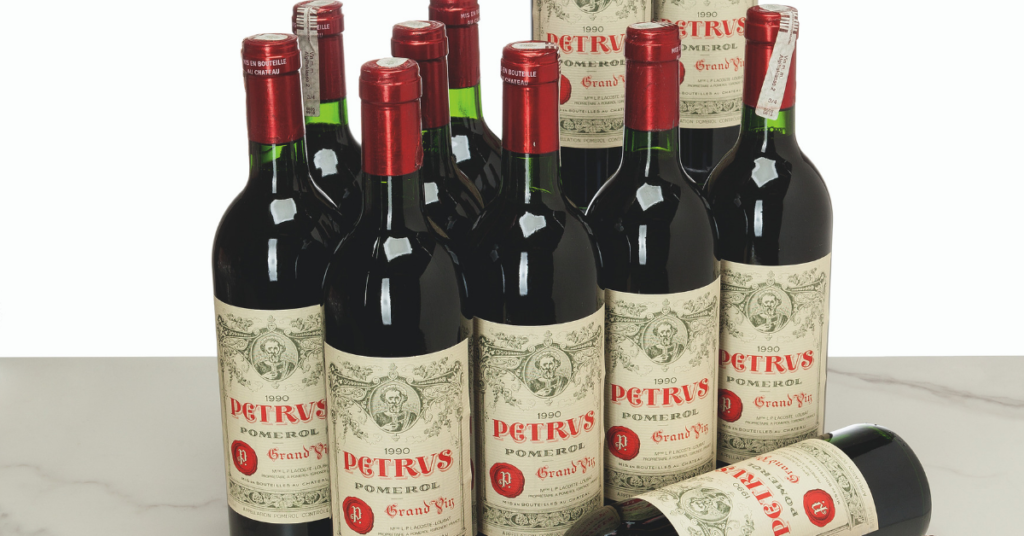
Petrus is the epitome of extravagance in Bordeaux. Single bottles can cost more $5,000, with the wine consistently selling for more than $1,000, even in comparatively humble vintages.
Endeavoring to explain why Petrus is more sought after or more expensive than another wine, or why a particular vintage is so noteworthy, is a bit like asking a fish to explain water. To a certain extent, the château and the vintage are notable simply because we all agree they are notable. It is a bit self-referential, with wine writers complimenting smaller producers by comparing them favorably to more well-known châteaux or vineyards or disparaging a particular vintage by saying it falls short of another.
The standard determination of which wines are best never operates in a vacuum. It is not objective or neutral; it is a comparative standard with different châteaux constantly being compared, judged and pitted against each other. It is a battle waged largely through metaphor and description, an attempt to translate a flavor sensation and an experience into words that convey to others who may never have tasted a particular wine before. A tasting note that includes notes of “cassis, cinnamon and gravel” is not meant to convey those flavors literally but instead to share, as if almost by code, the flavors of a wine. But the answer that “it’s expensive because it is” is a fairly unimpressive and solipsistically unsatisfying one. Ultimately, wines become more collectible when different factors coalesce together. Those conditions are a scarcity, a well-established brand that inspires faith in collectors to purchase a wine they may never have tasted personally before, and consistently brewing delicious drinks.
“Buy land – they aren’t making it anymore” (Mark Twain)
Scarcity begins in the vineyard. Only so many vines can be planted in a given area, which creates a maximum capacity of wine that can be produced,  and expanding the vineyard to new areas would alter the overall character of the wine because the fruit would be slightly different. Much has been written about Petrus’ 11.5 hectares (a hectare is 10,000 square meters, or 2.471 acres) of vineyards in the heart of Pomerol. The vineyards sit at the highest point in the appellation and each is situated on a unique geological curiosity. Whereas the majority of the clay soils in Pomerol are just a few million years old, the plateau has existed for more than 40 million years; it is a diverse and complex soil and subsoil system of blue clays that creates perfect conditions into which merlot vines can burrow. The so-called “button” of Petrus has ideal sun, the correct amount of water drainage and diurnal temperature shifts that help to preserve the freshness of the fruit. Petrus has long known that this fruit is its single most precious resource and even goes to the extreme of only harvesting in the afternoons after the morning dew has evaporated to avoid any miniscule risk of dew droplets diluting the wines.
and expanding the vineyard to new areas would alter the overall character of the wine because the fruit would be slightly different. Much has been written about Petrus’ 11.5 hectares (a hectare is 10,000 square meters, or 2.471 acres) of vineyards in the heart of Pomerol. The vineyards sit at the highest point in the appellation and each is situated on a unique geological curiosity. Whereas the majority of the clay soils in Pomerol are just a few million years old, the plateau has existed for more than 40 million years; it is a diverse and complex soil and subsoil system of blue clays that creates perfect conditions into which merlot vines can burrow. The so-called “button” of Petrus has ideal sun, the correct amount of water drainage and diurnal temperature shifts that help to preserve the freshness of the fruit. Petrus has long known that this fruit is its single most precious resource and even goes to the extreme of only harvesting in the afternoons after the morning dew has evaporated to avoid any miniscule risk of dew droplets diluting the wines.
“Life is Really Simple, but we insist on making it complicated” (Confucius)
The business of wine making has evolved quite a bit from its original roots of “put grapes in container, wait until booze happens.” Many modern wineries have optical sorting machines, reverse osmosis filtration, clay amphora and a litany of other gadgets to test and tinker with the juice. Those wineries are often at the very forefront of winemaking and have been responsible for some modern-day classic wines. Petrus, although long at a forefront of vineyard management, is confoundingly old-fashioned in the cellar. From the way the juice is pressed to how it is fermented and aged, Petrus is exceedingly traditional. The base philosophy is one that attempts to let the beautiful fruit show for itself. (Almost every winery in the world says the goal is to let fruit express itself, but it’s a fairly tired cliché in most winery tasting rooms. Many wineries even believe that they succeed in this goal, but very few truly follow through on that promise.) In the best vintages, the hand of the winemaker leaves a nearly invisible imprint on the wines, so all that is left in the glass is a pure expression of grapes grown at the top of a tiny hill in Bordeaux – the true height of simplicity. In short, Petrus never can be replicated because it is a perfect display of place.
“That split second when someone tastes something so delicious that their conversation suddenly derails and they blurt out something guttural” (Chef David Chang)
A lot is made in the wine business about the importance of scarcity and expression, but ultimately none of that matters unless the wine has a great answer to one simple question: how does it taste? In every single vintage, Petrus has a masterful answer to that question. Indeed, part of the allure of Petrus is that it manages to create wines of such consistent and beautiful quality even when Mother Nature tries its best to not cooperate. Tasting notes for Petrus invariably describe its elegance and its purity. They comment on its richness and concentration despite the fact that the wines never seem to be overwhelming. Petrus, like all great wine, is fundamentally compelling. If you put it into a lineup with any number of wines from around the world, invariably it will spawn conversation, invariably it will draw people to it, entice them to try more and get them to consider and think about what they are drinking. Beyond being merely a wine of place, it is a wine of presence. They create the conditions for a unique shared experience that brings together not merely everyone who shares a bottle but for everyone who tries the wine around the globe. Petrus is not a wine that you forget. It never is consigned to the recycling bin of your memory but demands a place among the trophy bottles of your mind.
“What’s in a name?” (William Shakespeare)
Relative to many other châteaux in Bordeaux, Petrus has a fairly short history. Although there is some evidence of grapes being grown in Pomerol as far back as the Roman era, the evidence of a particular château producing wines goes back less than two centuries, and even then the wines were far less well known than their counterparts on the other side of the Gironde. In Thomas Jefferson’s tour of Bordeaux, he commented on many châteaux that we still know today but there was never a mention of Petrus or even any of its neighbors. Until the 1950s, Petrus almost can be understood as a well-kept local secret, with industry insiders and Bordeaux aficionados familiar with the chateau, but most of the wine-consuming public favoring bigger names. Within a few decades, Petrus went from being nearly unknown outside of the industry to being one of the most expensive liquids on the planet. The name has become synonymous with Merlot and for investors in wine it has become one of the most reliable brands on the market. The fact that Petrus makes consistently excellent wines regardless of the vintage means that it is usually a good wine on which to bet. It is never possible to say with absolute certainty whether a wine will increase in value at a desired rate or whether it will be an amazing bottle to drink, but with a brand like Petrus you are making a safer bet than nearly every producer in the world.
“As you, yourself, have said, what other explanation can there be?” (Agatha Christie)
All of this begs a larger question of what makes the 2000 (or the 1998 or the 1990, for that matter) special even among the hallowed ranks of other great vintages like 1989, 1982, 1975 and 1961. In broad strokes, the easy answer to that question is that the weather was favorable that year. A warm spring helped with flowering, a dry spell that caused the vines to struggle was sated perfectly by a minor bit of rain in July followed by perfect months in August and September that allowed for both the sugars and the phenolic compounds in the grapes to develop in harmony with each other.
Perhaps the true answer is a bit more complicated, though. The journey of a grape to glass is a series of a thousands of small choices and factors. It has to do with how each of the tens of thousands of vines is pruned, how the bunches are culled in green harvesting and which ones are chosen to remain and which ones are discarded, whether or not the leaves shade the bunches or leave them exposed to the sunlight, the timing and veracity of vineyard treatments, the soil compaction, it’s the harvest date, the skill of those people who work the land, how they handle the fruit, the way the berries are sorted, the sun, the clouds, the yeasts, the oak barrels, the humidity and temperature in the cellar and several thousand other tiny factors that affect the lives of the grapes. Each of these factors can shift the direction of the wine, none of them sharply in one direction or the other, but a few degrees here and there, which can have a huge effect over the long course of the wine.
It is a dizzying level of complexity that ultimately means that 2000 Petrus, like all truly compelling wines, is irreplaceable. You could give all of the winemakers on the planet every resource possible for the next 1,000 years and they still never would be able to perfectly recreate the wine Petrus made in 2000. They may come close, but no one can ever hope to capture that same moment in time that Petrus bottled nearly two decades ago. Because although Petrus is a wine of presence, that presence is ultimately fleeting. With every cork that is pulled, the experience of this beautiful wine transforms from anticipation to memory, leaving one fewer bottle for the world to share.
The Heritage Auctions Wine Department will hold its next auction, in which six of the top seven pre-auction estimates are Chateau Petrus lots, Sept. 14-15 in Beverly Hills. The Sept. 14 session will be simulcast to Crown Wine Cellars in Hong Kong.
Parker Cronin is a Wine Specialist at Heritage Auctions.


This was very well written and so incredibly helpful. I appreciate your highlighting the truth while identifying what makes Petrus such a public allure.
Hi Tyler,
Thank you for sharing this!